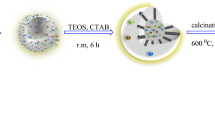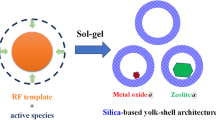Abstract
The yolk-shell LaMnO3 perovskite microspheres were fabricated by a novel, simple and mild soft template approach. A series of template-P123 concentrations (0-6.12 mmol∙L-1) were employed to optimize the most complete spheres. When the concentration of P123 is 3.0 mmol∙L-1, the obtained yolk-shell microspheres with a diameter of 200–700 nm were constructed by nanoparticles. The possible formation mechanism of the yolk-shell microspheres was revealed step by step via XRD, SEM, TEM, EDS and HRTEM. Molecules of P123 were suitably mixed with solvents for double shelled vesicles through self-assembly, which interacted with metal complexes to form P123-metal vesicles. After the removal of P123 and citric acid by calcination at 700 °C, the yolk-shell LaMnO3 microspheres with through-channels were obtained. Through-channels on the surface were due to citric acid and the solid core was attributed to the shrink of inner vesicles. Prepared yolk-shell microsphere samples possessed a larger surface area and a higher maximum NO conversion value of 78% at 314 °C for NO oxidation, compared with samples without the yolk-shell structure.
Similar content being viewed by others
References
Hong Z, Wang Z, Li X. Catalytic oxidation of nitric oxide (NO) over different catalysts: an overview. Catalysis Science & Technology, 2017, 7(16): 3440–3452
Chen J, Shen M, Wang X, et al. Catalytic performance of NO oxidation over LaMeO3 (Me = Mn, Fe, Co) perovskite prepared by the sol–gel method. Catalysis Communications, 2013, 37: 105–108
Wang Z, Lin F, Jiang S, et al. Ceria substrate–oxide composites as catalyst for highly efficient catalytic oxidation of NO by O2. Fuel, 2016, 166: 352–360
Shen M, Zhao Z, Chen J, et al. Effects of calcium substitute in LaMnO3 perovskites for NO catalytic oxidation. Journal of Rare Earths, 2013, 31(2): 119–123
Chen J, Shen M, Wang X, et al. The influence of nonstoichiometry on LaMnO3 perovskite for catalytic NO oxidation. Applied Catalysis B: Environmental, 2013, 134–135: 251–257
Shang D, Zhong Q, Cai W. Influence of the preparation method on the catalytic activity of Co/Zr1–xCexO2 for NO oxidation. Journal of Molecular Catalysis A: Chemical, 2015, 399: 18–24
Wen Y, Zhang C, He H, et al. Catalytic oxidation of nitrogen monoxide over La1–xCexCoO3 perovskites. Catalysis Today, 2007, 126(3–4): 400–405
Zhong S, Sun Y, Xin H, et al. NO oxidation over Ni–Co perovskite catalysts. Chemical Engineering Journal, 2015, 275: 351–356
Wang Z, Sun X, Liu J, et al. The NO oxidation performance over Cu/Ce0.8Zr0.2O2 catalyst. Surfaces & Interfaces, 2017, 6: 103–109
Bie S, Zhu Y, Su J, et al. One-pot fabrication of yolk–shell structured La0.9Sr0.1CoO3 perovskite microspheres with enhanced catalytic activities for oxygen reduction and evolution reactions. Journal of Materials Chemistry A: Materials for Energy and Sustainability, 2015, 3(44): 22448–22453
Wang B, Yu Q, Zhang S, et al. Gas sensing with yolk–shell LaFeO3 microspheres prepared by facile hydrothermal synthesis. Sensors and Actuators B: Chemical, 2018, 258: 1215–1222
Zhai Y, Whitten J J, Zetterlund P B, et al. Synthesis of hollow polydopamine nanoparticles using miniemulsion templating. Polymer, 2016, 105: 276–283
El-Said W A, Moharram A S, Hussein E M, et al. Design, synthesis, anticorrosion efficiency, and applications of novel Gemini surfactants for preparation of small-sized hollow spheres mesoporous silica nanoparticles. Materials Chemistry and Physics, 2018, 211: 123–136
Luo X, Pan Z, Pei F, et al. In situ growth of hollow Cu2O spheres using anionic vesicles as soft templates. Journal of Industrial and Engineering Chemistry, 2018, 59: 410–415
Ran H, Han L, Che S A. Synthesis of silica hollow spheres with diameter around 50 nm by anionic surfactant. Chemical Research in Chinese Universities, 2012, 28(3): 361–363
Lin L S, Song J, Yang H H, et al. Yolk–shell nanostructures: design, synthesis, and biomedical applications. Advanced Materials, 2018, 30(6): 1704639
Xu H, Wang W. Template synthesis of multishelled Cu2O hollow spheres with a single-crystalline shell wall. Angewandte Chemie International Edition, 2007, 46(9): 1489–1492
Cao A M, Hu J S, Liang H P, et al. Self-assembled vanadium pentoxide (V2O5) hollow microspheres from nanorods and their application in lithium-ion batteries. Angewandte Chemie International Edition, 2005, 44(28): 4391–4395
Zhang J, Jiang D, Chen Z, et al. Synthesis of calcium phosphate fluoride hybrid hollow spheres. Materials Letters, 2013, 91: 35–38
Discher D E, Eisenberg A. Polymer vesicles. Science, 2002, 297 (5583): 967–973
Onrubia J A, Pereda-Ayo B, De-La-Torre U, et al. Key factors in Sr-doped LaBO3 (B = Co or Mn) perovskites for NO oxidation in efficient diesel exhaust purification. Applied Catalysis B: Environmental, 2017, 213: 198–210
Over H, Kim Y D, Seitsonen A P, et al. Atomic-scale structure and catalytic reactivity of the RuO2(110) surface. Science, 2000, 287 (5457): 1474–1476
Elias J S, Stoerzinger K A, Hong W T, et al. In situ spectroscopy and mechanistic insights into CO oxidation on transition-metalsubstituted ceria nanoparticles. ACS Catalysis, 2017, 7(10): 6843–6857
Hwang J, Rao R R, Giordano L, et al. Perovskites in catalysis and electrocatalysis. Science, 2017, 358(6364): 751–756
Wang X, Wu X L, Guo Y G, et al. Synthesis and lithium storage properties of Co3O4 nanosheet-assembled multishelled hollow spheres. Advanced Functional Materials, 2010, 20(10): 1680–1686
Wei X, Hug P, Figi R, et al. Catalytic combustion of methane on nano-structured perovskite-type oxides fabricated by ultrasonic spray combustion. Applied Catalysis B: Environmental, 2010, 94 (1–2): 27–37
Chen J, He Z, Li G, et al. Visible-light-enhanced photothermocatalytic activity of ABO3-type perovskites for the decontamination of gaseous styrene. Applied Catalysis B: Environmental, 2017, 209: 146–154
Leofanti G, Padovan M, Tozzola G, et al. Surface area and pore texture of catalysts. Catalysis Today, 1998, 41(1–3): 207–219
Qi G, Li W. Pt-free, Pt-free, LaMnO3 based lean NOx trap catalysts. Catalysis Today, 2012, 184(1): 72–77
Kim C H, Qi G, Dahlberg K, et al. Strontium-doped perovskites rival platinum catalysts for treating NOx in simulated diesel exhaust. Science, 2010, 327(5973): 1624–1627
Acknowledgements
This work was supported by the National Natural Science Foundation of China (Grant No. 21607086), the Public Projects of Zhejiang Province (Grant No. 2016C33024), the Scientific and Technological Program of Ningbo City (Grant Nos. 2016C51025, 2017C50031 and 2017A610061), and the K. C. Wong Magna Fund from Ningbo University.
Author information
Authors and Affiliations
Corresponding author
Rights and permissions
About this article
Cite this article
Wu, L., Jiang, Q., Wang, L. et al. Formation mechanism of yolk–shell LaMnO3 microspheres prepared by P123-template and oxidation of NO. Front. Mater. Sci. 13, 77–86 (2019). https://doi.org/10.1007/s11706-019-0451-6
Received:
Accepted:
Published:
Issue Date:
DOI: https://doi.org/10.1007/s11706-019-0451-6




